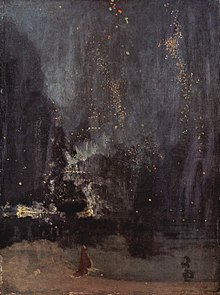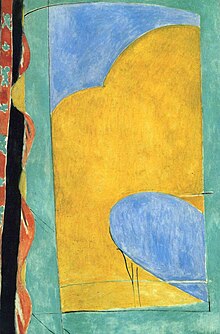Abstract art uses a visual language of form, color and line to create a composition which may exist with a degree of independence from visual references in the world.[1] Western art had been, from the Renaissance up to the middle of the 19th century, underpinned by the logic of perspective and an attempt to reproduce an illusion of visible reality. The arts of cultures other than the European had become accessible and showed alternative ways of describing visual experience to the artist. By the end of the 19th century many artists felt a need to create a new kind of art which would encompass the fundamental changes taking place in technology, science and philosophy. The sources from which individual artists drew their theoretical arguments were diverse, and reflected the social and intellectual preoccupations in all areas of Western culture at that time.[2]
Abstract art, nonfigurative art, nonobjective art, and nonrepresentational art are loosely related terms. They are similar, although perhaps not of identical meaning.
Abstraction indicates a departure from reality in depiction of imagery in art. This departure from accurate representation can be only slight, or it can be partial, or it can be complete. Abstraction exists along a continuum. Even art that aims for verisimilitude of the highest degree can be said to be abstract, at least theoretically, since perfect representation is likely to be exceedingly elusive. Artwork which takes liberties, altering for instance color and form in ways that are conspicuous, can be said to be partially abstract. Total abstraction bears no trace of any reference to anything recognizable. In geometric abstraction, for instance, one is unlikely to find references to naturalistic entities. Figurative art and total abstraction are almost mutually exclusive. But figurative and representational (or realistic) art often contains partial abstraction.
Both geometric abstraction and lyrical abstraction are often totally abstract. Among the very numerous art movements that embody partial abstraction would be for instance fauvism in which color is conspicuously and deliberately altered vis-a-vis reality, and cubism, which blatantly alters the forms of the real life entities depicted.[3][4]
History
Abstraction in early art and many cultures
Much of the art of earlier cultures – signs and marks on pottery, textiles, and inscriptions and paintings on rock – were simple, geometric and linear forms which might have had a symbolic or decorative purpose.[5] It is at this level of visual meaning that abstract art communicates. One can enjoy the beauty of Chinese calligraphy or Islamic calligraphy without being able to read it.
19th century
Three art movements which contributed to the development of abstract art were Romanticism, Impressionism and Expressionism. Artistic independence for artists was advanced during the 19th century. Patronage from the church diminished and private patronage from the public became more capable of providing a livelihood for artists.
Early intimations of a new art had been made by James McNeill Whistler who, in his painting Nocturne in Black and Gold: The falling Rocket, (1872), placed greater emphasis on visual sensation than the depiction of objects. An objective interest in what is seen, can be discerned from the paintings of John Constable, J M W Turner, Camille Corot and from them to the Impressionists who continued theplein air painting of the Barbizon school. Paul Cézanne had begun as an Impressionist but his aim - to make a logical construction of reality based on a view from a single point,[8] with modulated colour in flat areas - became the basis of a new visual art, later to be developed into Cubism by Georges Braque and Pablo Picasso.
Expressionist painters explored the bold use of paint surface, drawing distortions and exaggerations, and intense color. Expressionists produced emotionally charged paintings that were reactions to and perceptions of contemporary experience; and reactions toImpressionism and other more conservative directions of late 19th century painting. The Expressionists drastically changed the emphasis on subject matter in favor of the portrayal of psychological states of being. Although artists like Edvard Munch and James Ensor drew influences principally from the work of the Post-Impressionists they were instrumental to the advent of abstraction in the 20th century.Additionally in the late 19th century in Eastern Europe mysticism and early modernistreligious philosophy as expressed by theosophist Mme. Blavatsky had a profound impact on pioneer geometric artists like Wassily Kandinsky, and Hilma af Klint. The mystical teaching ofGeorges Gurdjieff and P.D. Ouspensky also had an important influence on the early formations of the geometric abstract styles of Piet Mondrian and his colleagues in the early 20th century.[9]


20th century
Post Impressionism as practiced by Paul Gauguin, Georges Seurat, Vincent van Gogh andPaul Cézanne had an enormous impact on 20th century art and led to the advent of 20th century abstraction. The heritage of painters like Van Gogh, Cézanne, Gauguin, and Seuratwas essential for the development of modern art. At the beginning of the 20th century Henri Matisse and several other young artists including the pre-cubist Georges Braque, André Derain, Raoul Dufy and Maurice de Vlaminckrevolutionized the Paris art world with "wild", multi-colored, expressive, landscapes and figure paintings that the critics called Fauvism. With his expressive use of color and his free and imaginative drawing Henri Matisse comes very close to pure abstraction in French Window at Collioure, (1914), View of Notre-Dame, (1914), and The Yellow Curtain from 1915. The raw language of color as developed by the Fauves directly influenced another pioneer of abstraction Wassily Kandinsky (see illustration).
Although Cubism ultimately depends upon subject matter, it became, along with Fauvism, the art movement that directly opened the door to abstraction in the 20th century. Pablo Picasso made his first cubist paintings based on Cézanne's idea that all depiction of nature can be reduced to three solids: cube, sphere and cone. With the painting Les Demoiselles d'Avignon 1907, Picasso dramatically created a new and radical picture depicting a raw and primitive brothel scene with five prostitutes, violently painted women, reminiscent of African tribal masks and his own new Cubist inventions. Analytic cubism was jointly developed by Pablo Picasso and Georges Braque, from about 1908 through 1912. Analytic cubism, the first clear manifestation of cubism, was followed by Synthetic cubism, practised by Braque, Picasso, Fernand Léger, Juan Gris, Albert Gleizes, Marcel Duchamp and countless other artists into the 1920s. Synthetic cubism is characterized by the introduction of different textures, surfaces, collage elements, papier collé and a large variety of merged subject matter. The collage artists like Kurt Schwitters and Man Ray and others taking the clue from Cubism were instrumental to the development of the movement called Dada.The Italian poet Marinetti published 'The Founding and Manifesto of Futurism' in 1909, which inspired artists such as Carlo Carra in,Painting of Sounds, Noises and Smells and Umberto Boccioni Train in Motion, 1911, to a further stage of abstraction and profoundly influenced art movements throughout Europe.[10]
During the 1912 Salon de la Section d'Or the poet Guillaume Appollinaire named the work of several artists including Robert and Sonia Delaunay, Orphism.[11] He defined it as, the art of painting new structures out of elements that have not been borrowed from the visual sphere, but had been created entirely by the artist...it is a pure art.[12]
Since the turn of the century cultural connections between artists of the major European and American cities had become extremely active as they strove to create an art form equal to the high aspirations of modernism. Ideas were able to cross-fertilize by means of artists books, exhibitions and manifestos so that many sources were open to experimentation and discussion, and formed a basis for a diversity of modes of abstraction. The following extract from,'The World Backwards', gives some impression of the inter-connectedness of culture at the time:
'David Burliuk's knowledge of modern art movements must have been extremely up-to-date, for the second Knave of Diamonds exhibition, held in January 1912 (in Moscow) included not only paintings sent from Munich, but some members of the German Die Brücke group, while from Paris came work by Robert Delaunay, Henri Matisse and Fernand Léger, as well as Picasso. During the Spring David Burliuk gave two lectures on cubism and planned a polemical publication, which the Knave of Diamonds was to finance. He went abroad in May and came back determined to rival the almanac Der Blaue Reiter which had emerged from the printers while he was in Germany'.
From 1909 to 1913 many experimental works in the search for this 'pure art' had been created: Francis Picabia painted Caoutchouc, 1909[13], The Spring, 1912,[14] Dances at the Spring[15] and The Procession, Seville, 1912[16]; Wassily Kandinsky painted Untitled (First Abstract Watercolor), 1910[17], Improvisation 21A, the Impression series, and Picture with a Circle (1911)[18]; František Kupka had painted the Orphist works, Discs of Newton (Study for Fugue in Two Colors), 1912[19] and Amorpha, Fugue en deux couleurs (Fugue in Two Colors), 1912; Robert Delaunay painted a series entitled Simultaneous Windows and Formes Circulaires, Soleil n°2 (1912-13)[20]; Léopold Survage created Colored Rhythm(Study for the film), 1913[21]; Piet Mondrian, painted Tableau No. 1 and Composition No. 11, 1913[22].And the search continued: The Rayist (Luchizm) drawings of Natalia Goncharova and Mikhail Larionov, used lines like rays of light to make a construction. Kasimir Malevich completed his first entirely abstract work, the Suprematist, 'Black Square', in 1915. Another of the Suprematist group' Liubov Popova, created the Architectonic Constructions and Spatial Force Constructions between 1916 and 1921.Piet Mondrian was evolving his abstract language, of horizontal and vertical lines with rectangles of colour, between 1915 and 1919, Neo-Plasticism was the aesthetic which Mondrian, Theo van Doesburg and other in the group De Stijl intended to reshape the environment of the future.


Abstraction in the 21st century
A commonly held idea is that pluralism characterizes art at the beginning of the 21st century. There is no consensus, nor need there be, as to a representative style of the age. There is an anything goes attitude that prevails; an "everything going on", and consequently "nothing going on" syndrome; this creates an aesthetic traffic jam with no firm and clear direction and with every lane on the artistic superhighway filled to capacity. Consequently magnificent and important works of art continue to be made albeit in a wide variety of styles and aesthetic temperaments, the marketplace being left to judge merit.
Digital art, computer art, internet art, hard-edge painting, geometric abstraction, appropriation, hyperrealism, photorealism, expressionism, minimalism, lyrical abstraction, pop art, op art, abstract expressionism, color field painting, monochrome painting, neo-expressionism, collage, decollage, intermedia, assemblage, digital painting, postmodern art, neo-Dada painting, shaped canvas painting, environmental mural painting, graffiti, figure painting, landscape painting, portrait painting, are a few continuing and current directions at the beginning of the 21st century.
Into the 21st century abstraction remains very much in view, its main themes: the transcendental, the contemplative and the timeless are exempified by Barnett Newman, John McLaughlin, and Agnes Martin as well as younger living artists. Art as Object as seen in the Minimalist sculpture of Donald Judd and the paintings of Frank Stella are still seen today in newer permutations. The poetic, Lyrical Abstraction and the sensuous use of color seen in the work of painters as diverse as Robert Motherwell, Patrick Heron, Kenneth Noland, Sam Francis, Cy Twombly, Richard Diebenkorn, Helen Frankenthaler, Joan Mitchell, among others.
There was a resurgence after the war and into the 1950s of the figurative, as neo-Dada, fluxus, happening, conceptual art, neo-expressionism, installation art, performance art, video art and pop art have come to signify the age of consumerism. The distinction between abstract and figurative art has, over the last twenty years, become less defined leaving a wider range of ideas for all artists.
Hiç yorum yok:
Yorum Gönder